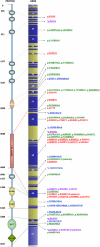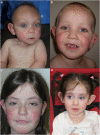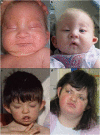How genetically heterogeneous is Kabuki syndrome?: MLL2 testing in 116 patients, review and analyses of mutation and phenotypic spectrum
- PMID: 22126750
- PMCID: PMC3306863
- DOI: 10.1038/ejhg.2011.220
How genetically heterogeneous is Kabuki syndrome?: MLL2 testing in 116 patients, review and analyses of mutation and phenotypic spectrum
Abstract
MLL2 mutations are detected in 55 to 80% of patients with Kabuki syndrome (KS). In 20 to 45% patients with KS, the genetic basis remains unknown, suggesting possible genetic heterogeneity. Here, we present the largest yet reported cohort of 116 patients with KS. We identified MLL2 variants in 74 patients, of which 47 are novel and a majority are truncating. We show that pathogenic missense mutations were commonly located in exon 48. We undertook a systematic facial KS morphology study of patients with KS at our regional dysmorphology meeting. Our data suggest that nearly all patients with typical KS facial features have pathogenic MLL2 mutations, although KS can be phenotypically variable. Furthermore, we show that MLL2 mutation-positive KS patients are more likely to have feeding problems, kidney anomalies, early breast bud development, joint dislocations and palatal malformations in comparison with MLL2 mutation-negative patients. Our work expands the mutation spectrum of MLL2 that may help in better understanding of this molecule, which is important in gene expression, epigenetic control of active chromatin states, embryonic development and cancer. Our analyses of the phenotype indicates that MLL2 mutation-positive and -negative patients differ systematically, and genetic heterogeneity of KS is not as extensive as previously suggested. Moreover, phenotypic variability of KS suggests that MLL2 testing should be considered even in atypical patients.
Figures



Similar articles
-
MLL2 mutation detection in 86 patients with Kabuki syndrome: a genotype-phenotype study.Clin Genet. 2013 Dec;84(6):539-45. doi: 10.1111/cge.12081. Epub 2013 Apr 26. Clin Genet. 2013. PMID: 23320472
-
Spectrum of MLL2 (ALR) mutations in 110 cases of Kabuki syndrome.Am J Med Genet A. 2011 Jul;155A(7):1511-6. doi: 10.1002/ajmg.a.34074. Epub 2011 Jun 10. Am J Med Genet A. 2011. PMID: 21671394 Free PMC article.
-
MLL2 mutation spectrum in 45 patients with Kabuki syndrome.Hum Mutat. 2011 Feb;32(2):E2018-25. doi: 10.1002/humu.21416. Epub 2010 Dec 7. Hum Mutat. 2011. PMID: 21280141
-
Kabuki syndrome revisited.J Hum Genet. 2012 Apr;57(4):223-7. doi: 10.1038/jhg.2012.28. Epub 2012 Mar 22. J Hum Genet. 2012. PMID: 22437206 Review.
-
Kabuki syndrome: clinical and molecular diagnosis in the first year of life.Arch Dis Child. 2015 Feb;100(2):158-64. doi: 10.1136/archdischild-2013-305858. Epub 2014 Oct 3. Arch Dis Child. 2015. PMID: 25281733 Review.
Cited by
-
Clinical and molecular analysis of Guangxi patients with Kabuki syndrome and KMT2D mutations.Heliyon. 2023 Sep 24;9(10):e20223. doi: 10.1016/j.heliyon.2023.e20223. eCollection 2023 Oct. Heliyon. 2023. PMID: 37810849 Free PMC article.
-
ACTB Loss-of-Function Mutations Result in a Pleiotropic Developmental Disorder.Am J Hum Genet. 2017 Dec 7;101(6):1021-1033. doi: 10.1016/j.ajhg.2017.11.006. Am J Hum Genet. 2017. PMID: 29220674 Free PMC article.
-
Congenital hyperinsulinemic hypoglycemia (HH) requiring treatment as the presenting feature of Kabuki syndrome.Clin Case Rep. 2023 May 26;11(6):e7336. doi: 10.1002/ccr3.7336. eCollection 2023 Jun. Clin Case Rep. 2023. PMID: 37257167 Free PMC article.
-
Infrequent Manifestations of Kabuki Syndrome in a Patient with Novel MLL2 Mutation.Mol Syndromol. 2012 Oct;3(4):180-4. doi: 10.1159/000342253. Epub 2012 Aug 30. Mol Syndromol. 2012. PMID: 23239960 Free PMC article.
-
Persistent Hyperinsulinism in Kabuki Syndrome 2: Case Report and Literature Review.Clin Pract. 2016 Aug 23;6(3):848. doi: 10.4081/cp.2016.848. eCollection 2016 Aug 8. Clin Pract. 2016. PMID: 27777708 Free PMC article.
References
-
- Kuroki Y, Suzuki Y, Chyo H, Hata A, Matsui I. A new malformation syndrome of long palpebralfissures, large ears, depressed nasal tip, and skeletal anomalies associated with postnatal dwarfism and mental retardation. J Pediatr. 1981;99:570–573. - PubMed
-
- Niikawa N, Matsuura N, Fukushima Y, Ohsawa T, Kajii T. Kabuki make-up syndrome: a syndrome of mental retardation, unusual facies, large and protruding ears, and postnatal growth deficiency. J Pediatr. 1981;99:565–569. - PubMed
-
- Adam MP, Hudgins L. Kabuki syndrome: a review. Clin Genet. 2005;67:209–219. - PubMed
-
- Paulussen ADC, Stegmann APA, Blok MJ, et al. MLL2 mutation spectrum in 45 patients with Kabuki syndrome. Hum Mutat. 2011;32:E2018–E2025. - PubMed
Publication types
MeSH terms
Substances
Supplementary concepts
LinkOut - more resources
Full Text Sources
Medical
Molecular Biology Databases
Miscellaneous

